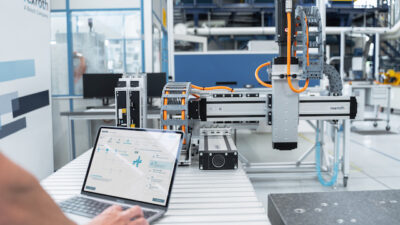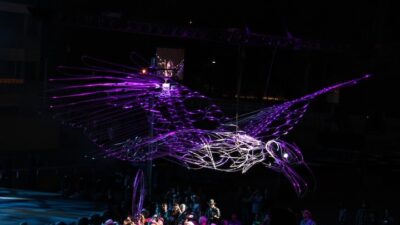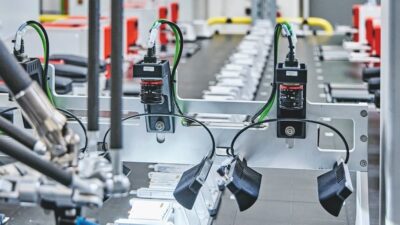Available in a gamut of sizes, types, and design configurations, cylinder actuators form the main output device of a hydraulic motion system, and often the most visible part. These actuators convert hydraulic fluid pressure into rapid, controllable linear motion and force to move loads. A typical actuator consists of the cylinder body, end caps, piston, piston rod, seals, and bearing surfaces ...
Available in a gamut of sizes, types, and design configurations, cylinder actuators form the main output device of a hydraulic motion system, and often the most visible part. These actuators convert hydraulic fluid pressure into rapid, controllable linear motion and force to move loads.
A typical actuator consists of the cylinder body, end caps, piston, piston rod, seals, and bearing surfaces for piston and rod. Designed for various pressures, ratings up to 3,000 psi (continuous) apply to industrial units; up to 5,000 psi for mill and press type units. Stroke lengths to 10 ft and cylinder diameters to 8 in. are available, with much larger units made for special applications.
From a basic relationship of hydraulics (Pascal’s Law), linear force magnitude developed by a cylinder is the system fluid pressure times the piston’s effective area over which pressure acts, or F = PA. Friction and other real-world losses will reduce results from this simple relation.
Many configurations
The simplest actuator configuration is a single-acting cylinder , where fluid is ported to one side of the piston, producing output force and motion only in one direction. Gravity or external springs return the piston to its starting position as the fluid is returned to the reservoir. A double-acting cylinder ports fluid to either side of the piston to produce force/motion when extending and retracting the piston rod (see graphic). Sealing between piston OD and cylinder ID must handle both directions of motion. A variant here is a double-end rod cylinder that adds a piston rod extending through the cylinder’s rear end cap.
The double-acting cylinder is the most common hydraulic cylinder type, providing output stroke in two directions. Industrial cylinders favor tie-rod construction to lock cylinder body, head, and end cap in place.
A typical double-acting cylinder produces somewhat greater force when extending than when retracting—with equal pressure applied on each side of the piston—due to different effective areas exposed to the hydraulic fluid. The rod-side piston area is smaller than the head side, resulting in less force on the retract stroke, says Pascal’s Law. A double-end rod cylinder has essentially the same area on each side of the piston, and doesn’t exhibit this differential cylinder effect.
A variant of the above actuator types is a ram cylinder , designed with a robust diameter piston rod approaching full-piston diameter that prevents rod bending in a long-stroke horizontal unit or buckling under high vertical loads as in a press or stamping application.
The piston connects to a high-strength steel piston rod whose opposite end comes with various rod-end connections (see graphic). Surface hardened or chrome-plated rods are often used with ultra-fine surface finish that’s key to long seal life. Piston OD must fit precisely to the cylinder ID. Each must be precisely cylindrical and extremely finely finished for smooth output motion.
The latest industrial cylinders can incorporate sensor feedback and an electrohydraulic servo valve for sophisticated speed and position control of loads—not only full stroke (in/out) or rough positioning. Applications range from production machine tools and material handling to steel mill actuators, nuclear power plant controls, and passenger and freight elevators.
Online Extra Hydraulic cylinder controls, applications As mentioned in the main article, control electronics associated with hydraulic cylinders help increase the performance of these devices. At the high end are electrohydraulic proportional (servo) valves and sophisticated feedback sensors integrated into the cylinder that challenge electric drives for certain applications. More common are directional control valves that actuate cylinders automatically or manually.
Hydraulic cylinders work in numerous applications. A large sector is “mobile hydraulics,” where hydraulic systems power various motions and tools for off-road vehicles and equipment. Here, a reversing directional valve (single- or double-acting, depending on cylinder type) typically controls hydraulic fluid flow control to and from the cylinder.
Differential cylinders produce greater force in extension than in retraction (see main article). However, if it’s important to have equal force output in each direction, the rod-side supply pressure could be increased to make that adjustment. Another effect of the differential cylinder is faster speed in retraction than extension, which seems counterintuitive at first. It’s explained by less volume capacity on the cylinder’s rod-side allowing for faster retraction—with equal fluid flow going to both ends of the cylinder.
In the U.S., numerous standards of the National Fluid Power Association (NFPA) are widely applied in the design and manufacture of hydraulic cylinders.
Water hydraulics While hydraulic cylinders operate predominantly on pressurized hydraulic oil, a niche technology exists—called “water hydraulics”—that applies pure tap water at high pressures as the “hydraulic fluid” to power cylinders, actuators, and other devices. Water hydraulics has a substantial following in Europe, but various products and systems are available elsewhere. One notable supplier of the technology is the Danish company Danfoss A/S, with its high-pressure water solution trade-marked “ Nessie .”
More cylinder types A multi-stage telescoping cylinder delivers increased stroke length from a cylinder body of given length. Total stroke can be about four times the retracted length of the unit, with either single- or double-acting cylinder styles available. Output force is highest with the first stage and decreases as each additional stage extends. These cylinders are often of the “ram” type (see main article). Telescoping cylinders are commonly used in mobile hydraulic systems.
A cushioned cylinder refers to the incorporation of a device in the actuator to minimize shock loads as the piston comes to the end(s) of its stroke. Cushioning can be accommodated at one or both ends of the cylinder typically by means of a metering device that restricts flow at the applicable cylinder outlet port(s) to slow the piston’s motion at end of stroke.
Certain manufacturing applications require a short-stroke cylinder, offered by various suppliers, that provide shorter piston strokes and smaller body sizes than standard cylinders. One manufacturer of these actuators, Mack Corp ., offers an extensive number of basic cylinder configurations plus additional custom designs. The company offers a free wall chart describing 88 basic cylinder configurations it offers.
Support for dynamic stage and cinema productions is among the wide applications of hydraulic technology. For an interesting example of a cinema application, see this month’s article, ‘ Automation Stars in a Supporting Role ,’ describing an automated hydraulic system at work on the set of the film ‘Master and Commander: The Far Side of the World.’ In particular, a system of eight hydraulic cylinders puts a replica of H.M.S. Surprise put through its paces.



